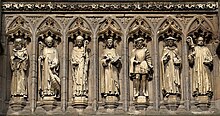Henry Hastings, 3rd Earl of Huntingdon
Henry Hastings, 3rd Earl of Huntingdon | |
|---|---|
Catherine Pole | |
| Occupation | Administrator, diplomat, and military commander |
Henry Hastings, 3rd Earl of Huntingdon,
Early life
Education
Hastings was born in
Marriage and imprisonment in the Tower of London
His father was a political ally of John Dudley, 1st Duke of Northumberland, and to further their alliance the two elder politicians arranged the marriage of their children. On 21 May 1553, Henry was wed to Katherine Dudley, daughter of Northumberland by Jane Guildford.
In 1553, Edward VI was dying and his appointed heir was his cousin Lady Jane Grey, Northumberland's daughter-in-law. Jane's reign lasted only from 10 to 19 July 1553 until her cousin Mary I of England prevailed. Due to his marital alliance, Henry backed Northumberland in his attempt to divert the succession in favour of Lady Jane Grey in July 1553, and on Mary Tudor's triumph he found himself incarcerated in the Tower of London. Mary attempted to reconcile with the Hastings family and soon they were free again and by oath loyal to her.[citation needed]
Henry entered the household of his great-uncle
Political career

He had been loyal to
His father died on 25 January 1560 and Henry became the third Earl of Huntingdon. He thus assumed responsibility for his widowed mother and his ten siblings.
Stunted rise to power
With his humanist education, experience of court life, and a brother-in-law,
President of the Council of the North
However, he was still useful to her. It was doubtless felt that the earl's own title to the crown was a pledge that he would show scant sympathy with the advocates of Mary's claim. For three months during the northern uprising in the autumn of 1569, he assisted George Talbot, 6th Earl of Shrewsbury to remove the Scottish queen from Wingfield Manor to Tutbury.[8] He is often mentioned - negatively - in coded letters from Mary, Queen of Scots, to the French ambassador.[10] He was later one of the peers at her trial in 1586.
Elizabeth formally recognised his service by creating him a
He was prominent and active in the preparations of 1588 for the Spanish invasion.
Later life

Having gone north to Newcastle to oversee the musters in the autumn of 1595, Huntingdon planned to join his wife at court for Christmas. On his return to York in late November, however, he fell ill with a fever and died there on 14 December 1595.[11]
At court, Elizabeth went out of her way to comfort his distraught widow, though she did little to mitigate the debts. Childless, Huntingdon had educated
A portrait of Huntingdon in armour dated 1588 now hangs in the Tower. Huntingdon was responsible for the compilation of an elaborate history of the Hastings family, a manuscript copy of which is now in the British Museum.[8]
Notes
- ^ a b Claire Cross, "Hastings, Henry, third earl of Huntingdon (1536?–1595)", Oxford Dictionary of National Biography, Oxford University Press, 2004; online edn, January 2008 accessed 11 May 2017
- ^ Cross 1966, p. 35.
- ^ Cross 1966, p. 40.
- ^ Cross 1966, p. 33.
- ^ Stone, Lawrence, The crisis of the aristocracy, 1558–1641, Oxford: Oxford University Press, 2002 (reprint), 341.
- ^ Cross 1966, p. 276.
- ^ Cross 1966, pp. 257–58.
- ^ a b c One or more of the preceding sentences incorporates text from a publication now in the public domain: Chisholm, Hugh, ed. (1911). "Huntingdon, Earls of s.v. Henry, the 3rd earl". Encyclopædia Britannica. Vol. 13 (11th ed.). Cambridge University Press. p. 949.
- ^ Cross 1966, pp. 143–5.
- S2CID 256720092.
- ^ Michael Brennan, Noel Kinnamon, Margaret Hannay, The Letters of Rowland Whyte to Sir Robert Sidney (Philadelphia, 2013), pp. 119-121.
References
- Cross, Claire (1966). Puritan Earl 3rd Earl of Huntingdon. London: Palgrave Macmillan Limited. OCLC 1084422747.
External links
- Biography
- . New International Encyclopedia. 1905.
